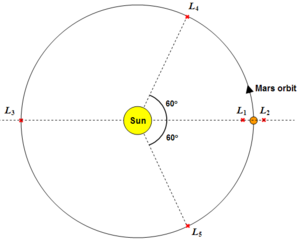Difference between revisions of "Lagrangian point"
m |
|||
| Line 25: | Line 25: | ||
==Uses of the Mars <math>L_1</math> point== | ==Uses of the Mars <math>L_1</math> point== | ||
* [[early warning system (solar radiation)|An "early warning system" to notify settlers about the onset of solar storms]]. | * [[early warning system (solar radiation)|An "early warning system" to notify settlers about the onset of solar storms]]. | ||
| + | |||
| + | [[category:orbital dynamics]] | ||
| + | [[category:physics]] | ||
Revision as of 22:21, 26 November 2007
Contents
Definition
A Lagrangian point is a point of interplanetary gravitational stability in a two body orbital configuration.
Positions of the Lagrangian points
The simplest Lagrangian point to understand is the "first Lagrangian" (or ) point between the Earth and the Sun. The point at which the gravitational pull of the Sun and the gravitational pull of the Earth cancels out () creates an island of gravitational stability where space observatories, or indeed space stations, can be positioned.
is located on the opposite side of the smallest orbital body (in this case, the Earth) to . This very stable region is also useful to space observatories observing the cosmos. The Earth in this case will be constantly eclipsing the Sun, allowing sensitive optics to operate free of noise emitted from the Sun.
is a less-stable Lagrangian point on the far side of the Sun. In this case, the Earth's gravitational force is negligable, allowing other planet's orbits to interfere with the gravitational stability of the region.
and are points leading and trailing the orbiting body at an angle of approximately 60° from the Earth-Sun line. These points are also known as "Trojan points" where asteroids (known as Trojan asteriods) become captured by the relative gravitational stability and orbit with the orbital body.
Current missions using the Lagrangian points of the Earth-Sun system
- The Solar and Heliospheric Observatory (SoHO) - A multi-instrument observatory contantly observing the Sun.
- Advanced Composition Explorer (ACE) - An in-situ observatory measuring the properties of the solar wind and solar radiation.
- Wilkinson Microwave Anisotropy Probe (WMAP) - Surveying the sky, observing the microwave radiation left over by the Big Bang.













